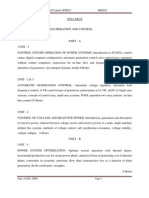Non Technical Losses Reduction
Non Technical Losses Reduction
Uploaded by
RajCopyright:
Available Formats
Non Technical Losses Reduction
Non Technical Losses Reduction
Uploaded by
RajOriginal Description:
Copyright
Available Formats
Share this document
Did you find this document useful?
Is this content inappropriate?
Copyright:
Available Formats
Non Technical Losses Reduction
Non Technical Losses Reduction
Uploaded by
RajCopyright:
Available Formats
VOLTA RIVER AUTHORITY
NON TECHNICAL LOSSES REDUCTION A PRESENTATION DURING UPDEA SCIENTIFIC COMMITTEE MEETING IN DURBAN, SA THOMPSON AGALAB
NON TECHNICAL LOSSES REDUCTION
BACKGROUND
A menace in most African utility operations. Occur as a result of distribution operational problems. Loss of huge sums of revenue to many utilities. Efforts taken to reduce non-technical losses in African Utilities have been varied, uncoordinated, unsustainable and hence ineffective. Approached with well-strategize customer centred plans.
NON TECHNICAL LOSSES REDUCTION A menace in most African utility operations. Occur as a result of distribution operational problems. Loss of huge sums of revenue to many utilities. Efforts taken to reduce non-technical losses in African Utilities have been varied, uncoordinated, unsustainable and hence ineffective. Approached with well-strategize customer centred plans.
This presentation will seek to address the following issues
Definition and analysis of non-technical losses. International comparison of non-technical losses in the sub-region of West Africa. Identified causes of non-technical losses Analysis of the causes of non-technical losses Measures to combat non-technical losses Performance monitoring indicators.
DEFINITION AND ANALYSIS OF NONTECHNICAL LOSSES Power system losses refer to the difference between bulk energy purchased from the national grid and the total energy accounted for expressed as a percentage. The total energy accounted for comprises of billed energy, street lighting and temporary lighting and energy consumption in VRA/NED sub transmission premises.
Power system losses can be divided into two categories: technical and nontechnical . Technical losses are due to resistance and iron core losses which occur during the transmission and distribution of electric power. These are naturally occurring losses Consist mainly of power dissipation in transmission lines, power transformers, measurement systems, etc.
Technical losses are possible to compute and control. Non-technical losses are due to human manipulation or errors and are therefore external to the power systems. Non-technical losses are very difficult to measure.
Background of NED Losses
The system losses in NED stood at 12% in 1990 and this increased steadily to 31% in 2003 and improved to 18.8% in 2008. NED losses started rising from 1996 when the government embarked upon National Electrification Project As a result long transmission lines and distribution networks were constructed over a short period given rise to sudden increase in both technical and non-technical losses.
Very long distribution lines with very little load at the tail end. Existing networks are saddled with very old and undersized cables. Also in the process of having most rural areas connected in a short period, standards of cable and metering might have been compromised.
NED losses trend from 1990 to 2008
35 30 25 20 15 10 5 0 1990 1991 1992 1993 1994 1995 1996 1997 1998 1999 2000 2001 2002 2003 2004 2005 2006 2007 2008 18 12 1 3 .175 13
3 1 .33 0 . 3 2 9 2 8 .229 . 1 27 2 4 .8 2 4 .5 2 1 .8 2 0 .128 . 8 1 9 .179 . 6 1 7 .3 Losses
Experience of most utilities has shown that losses worsen as mass electrification programme are embarked upon
Utility Eskom ECG NED
Period of mass electrification 1990 1996 1999 - 2000 1999 - 2000
losses 40% 32% 31%
Causes of Non-Technical Loses
Power theft;
defined as a conscience attempt by a person to reduce or eliminate the amount of money he or she will owe the utility for electric energy. Illegal Connection Pure Administrative
Self line Constructions
Causes of Non-Technical Loses( ctd)
Meter related problems Meter bypass/ tamper
Wrong readings U- TOUCH High meter position Faulty meter Meter ratings Over aged meters Incorrect C.T. multiplying factor Meter Transfers
Causes of Non-Technical Loses (ctd)
Billing Problems Premises connected but a/cs not set up in System. Wrong classification Under keying of meter reading Customers with zero readings Over clocked meter readings Un metered/flat rate supplies
Under estimation Unpaid bills
Analysis of power theft in NED
item Jan Feb Mar Apr May Jun Jul Aug Sept Total Premises visited 1000 1000 1000 1000 1000 1000 1000 1000 1000 9000
Illegal 54 Connection
56
105
76
119
93
85
72
24
686
Meter bypass Tampered Meters 15
13
40
16
11
74
% Power theft
6.9
6.4
11.2
8.2
12.6
11.8
10.3
9.6
3.1
8.9
Losses due to meter related -2007
item No.of meters No. Faulty Jan Feb Mar Apr May Jun Jul Aug
134,475 136,800 138,762 139,460 140,487 141,052 142,067 143,232
13
11
21
17
18
Unsealed 53,898
54,720
55,504
55,784
56,194
56,194
56,826
57,292
% Losses
40
40
40
40
40
40
40
40
Measures to check illegal connections i. LORG-Loss Reduction Gang powers to check, remove, charge penalties and refer to Legal Department for the prosecutions of people caught for illegal connections. ii. Monetary Award For each illegal connection reported and verified to be true. iii. Zero consumption Report run every month for field check
iv. Consumption analysis Report A customer whose consumption is abnormal is flagged for further investigations. v. Meter bypass penalty Penalty charge of Gh 100 plus six months estimated consumption vi. Meter tempering Penalty charge of Gh 100 plus six months estimated consumption and full cost of meter.
Thank You
You might also like
- Cash Flow Statement ProjectDocument73 pagesCash Flow Statement Projectmsl 78660% (10)
- Apricot Sales Pres Final 12-12-22Document20 pagesApricot Sales Pres Final 12-12-22Stephanie TaylorNo ratings yet
- Circular Apparel Status Paper 140422Document49 pagesCircular Apparel Status Paper 140422Debasree ChowdhuryNo ratings yet
- Electromagnetic Compatibility of Industrial Networks and FieldbusesDocument38 pagesElectromagnetic Compatibility of Industrial Networks and FieldbusesCarlos ChocobarNo ratings yet
- EEE 805 Assignment Questions For Chapter 20Document11 pagesEEE 805 Assignment Questions For Chapter 20ayeniNo ratings yet
- PV PQ Bus Switching Power Flow Pscc2008 - 128Document7 pagesPV PQ Bus Switching Power Flow Pscc2008 - 128kcirrenwodNo ratings yet
- A Report On Fault Analysis of Power Distribution SystemsDocument19 pagesA Report On Fault Analysis of Power Distribution SystemsKalyan Ranjan100% (3)
- Termite ControlDocument7 pagesTermite ControlphilipyapNo ratings yet
- Presentation On At&c Loss ReductionDocument35 pagesPresentation On At&c Loss ReductionMaruthi Kumar Mallepalli100% (1)
- Energy MeterDocument71 pagesEnergy Metersahil4INDNo ratings yet
- Load Management Is The Process ofDocument21 pagesLoad Management Is The Process ofmvr_venkiNo ratings yet
- Ethiopia To Import Half MLN Electric Vehicles in 10 Years To Promote Electric MobilityDocument3 pagesEthiopia To Import Half MLN Electric Vehicles in 10 Years To Promote Electric MobilityAhmedNo ratings yet
- Amr Automatic Meter ReadingDocument13 pagesAmr Automatic Meter ReadingSukhwinder Singh Gill100% (1)
- More Papers and Presentations Available On Above Site: Document byDocument10 pagesMore Papers and Presentations Available On Above Site: Document byBharadwaj SanthoshNo ratings yet
- Module 3 - Electricity MeteringDocument50 pagesModule 3 - Electricity MeteringOlusegun OdubanjoNo ratings yet
- Power Factor ImprovementDocument11 pagesPower Factor Improvementvikas.tiran100% (1)
- أسئلة دورات تجميعDocument131 pagesأسئلة دورات تجميعRashed Abu AlsondosNo ratings yet
- Electricity Theft Detection: Using Machine LearningDocument23 pagesElectricity Theft Detection: Using Machine LearningAnshul Shrivastava 4-Yr B.Tech. Electrical Engg., IIT (BHU) Varanasi100% (1)
- Minimization of Power Loss in Distribution Networks by Different Techniques PDFDocument7 pagesMinimization of Power Loss in Distribution Networks by Different Techniques PDFOreana Garcia AlarconNo ratings yet
- IEEE Paper Smart Grid TechnologyDocument5 pagesIEEE Paper Smart Grid TechnologySujata HarugadeNo ratings yet
- Distribution Reliability OKDocument39 pagesDistribution Reliability OKAssyakurNo ratings yet
- Electrical Energy Audit and SafetyDocument13 pagesElectrical Energy Audit and SafetyRam Kapur100% (1)
- Fault Detection On Radial Power Distribution Systems Using Fuzzy LogicDocument8 pagesFault Detection On Radial Power Distribution Systems Using Fuzzy LogicDa DebebeNo ratings yet
- Smart GridDocument30 pagesSmart GridkumarchaturvedulaNo ratings yet
- Economic Operation of Power SystemsDocument43 pagesEconomic Operation of Power SystemsJoey MallillinNo ratings yet
- Chapter 13 PduDocument57 pagesChapter 13 Pduarslan khalidNo ratings yet
- Renewable Energy Final PaperDocument52 pagesRenewable Energy Final PaperMashaal FNo ratings yet
- Lecture of Power Distribution and UtilizationDocument20 pagesLecture of Power Distribution and UtilizationhamzaNo ratings yet
- NTC-PGT ReportDocument29 pagesNTC-PGT ReportTawanda Daniel Dengu100% (1)
- RNRN RN : Electric Energy Systems and Engineering SeriesDocument194 pagesRNRN RN : Electric Energy Systems and Engineering SeriesRaut SumeshNo ratings yet
- SolutionDocument1 pageSolutionMuntadher Abbas100% (1)
- 03 - Lectures of Load Forecasting - NnatDocument89 pages03 - Lectures of Load Forecasting - NnatMuhammad Yunus Nurdin0% (1)
- 2 - Reduction of Technical and Non-Technical Losses in Distribution NetworksDocument64 pages2 - Reduction of Technical and Non-Technical Losses in Distribution NetworksIssa SleehatNo ratings yet
- DPR Distribution System PlanningDocument8 pagesDPR Distribution System PlanningNitesh-02No ratings yet
- Generation PlanningDocument19 pagesGeneration PlanningAyesha MughalNo ratings yet
- Usaid Technical Note - Advancing Power Sectors' Self-Reliance Through Electricity System Loss ReductionDocument12 pagesUsaid Technical Note - Advancing Power Sectors' Self-Reliance Through Electricity System Loss ReductionYahaya Fatawu100% (1)
- V S DDocument17 pagesV S DveguruprasadNo ratings yet
- Power System Expansion PlanningDocument27 pagesPower System Expansion Planningsrinimeha@gmail.comNo ratings yet
- Distribution AutomationDocument26 pagesDistribution AutomationBiswa Mohan Pati0% (1)
- Omses 4.3 PDFDocument20 pagesOmses 4.3 PDFsrinimeha@gmail.com100% (1)
- M.E.Electrical Power System - 2 PDFDocument32 pagesM.E.Electrical Power System - 2 PDFAnonymous 9VcxlFErfNo ratings yet
- 38,202 - Renewable ProjectDocument40 pages38,202 - Renewable ProjectAnas AyubNo ratings yet
- Guidelines On Ee of Electrical InstallationsDocument45 pagesGuidelines On Ee of Electrical InstallationsAnonymous MDkp0hnb3lNo ratings yet
- Reliability of Distributed SystemDocument14 pagesReliability of Distributed SystemYogesh MishraNo ratings yet
- Energy Efficiency in Agricultural SectorDocument19 pagesEnergy Efficiency in Agricultural SectorRhythm Nikhra100% (1)
- CEB Supply Services Code DD1Document108 pagesCEB Supply Services Code DD1Udara DissanayakeNo ratings yet
- Chapter - 1 1.1 OverviewDocument21 pagesChapter - 1 1.1 OverviewTirumalarao PechettyNo ratings yet
- Report On Restructuring of APDRPDocument76 pagesReport On Restructuring of APDRPjoydeep_d3232100% (1)
- LectureSix - Project ManagementDocument26 pagesLectureSix - Project Managementhabte gebreial shrashrNo ratings yet
- Faults in Electrical Power SystemDocument4 pagesFaults in Electrical Power Systemmaruf048No ratings yet
- Module Information Module Title Electric Drives and Control Module Code MMD2511Document4 pagesModule Information Module Title Electric Drives and Control Module Code MMD2511Ashley KaNo ratings yet
- Eee-Viii-power System Operation and Control (06ee82) - NotesDocument138 pagesEee-Viii-power System Operation and Control (06ee82) - Noteskeerthanavijaya100% (3)
- Smart Corridor LightingDocument39 pagesSmart Corridor LightingjabezNo ratings yet
- Electricity MeteringDocument48 pagesElectricity MeteringchanukaNo ratings yet
- EC&A-Model - 2 - Energy Efficiency in Electrical Systems-01-10-24Document139 pagesEC&A-Model - 2 - Energy Efficiency in Electrical Systems-01-10-24krganeshkr98No ratings yet
- Switch Gear &protection: Role of SCADA in AnDocument10 pagesSwitch Gear &protection: Role of SCADA in AnNicholas SheltonNo ratings yet
- WindmillDocument23 pagesWindmillManav KohliNo ratings yet
- Renewable Energy Tariffs and Incentives in Indonesia: Review and RecommendationsFrom EverandRenewable Energy Tariffs and Incentives in Indonesia: Review and RecommendationsNo ratings yet
- Technical Specifications Dinner in The SkyDocument11 pagesTechnical Specifications Dinner in The SkykharkhourNo ratings yet
- Employment Trends Survey - MaFoi Consultancy 2011Document24 pagesEmployment Trends Survey - MaFoi Consultancy 2011MTC Global TrustNo ratings yet
- CrossRates - November 6 2017Document1 pageCrossRates - November 6 2017Tiso Blackstar GroupNo ratings yet
- Checkout GHL IntegrationDocument2 pagesCheckout GHL Integrationvijaysharma771890No ratings yet
- DLL - TRENDS-GlobalizationDocument3 pagesDLL - TRENDS-GlobalizationChristine Joy MarananNo ratings yet
- Francia Vs Meycauyan, BulacanDocument1 pageFrancia Vs Meycauyan, BulacanDindo Palgan100% (1)
- Special Power of AttorneyDocument2 pagesSpecial Power of AttorneyNicolo Jay Pajarito100% (1)
- Adobe Scan 27-May-2024Document1 pageAdobe Scan 27-May-2024Gaurav_Mehra_1313No ratings yet
- Problem 3 PrecalDocument6 pagesProblem 3 PrecalKateAlbero100% (1)
- Power Quality-Model QPDocument3 pagesPower Quality-Model QPKarthick GuberanNo ratings yet
- TDS - Flobas RPF-210 - FbasDocument1 pageTDS - Flobas RPF-210 - FbasJame EgaNo ratings yet
- Lembar Jawaban 1 UPK (Kevin J)Document12 pagesLembar Jawaban 1 UPK (Kevin J)kevin jonathanNo ratings yet
- CAR and EAR Brief WriteupDocument17 pagesCAR and EAR Brief Writeuppradeeprajendran1988No ratings yet
- A. Brief History/Background of The Company/company Profile Brief HistoryDocument7 pagesA. Brief History/Background of The Company/company Profile Brief HistoryIan TalaueNo ratings yet
- ACR On Food SafetyDocument4 pagesACR On Food SafetyMaitem Stephanie GalosNo ratings yet
- Torsion Summarized LectureDocument12 pagesTorsion Summarized LectureKamal AliNo ratings yet
- Home Visitation FormDocument2 pagesHome Visitation Formxainamagdfhdg96% (98)
- Management Theory Chapter 9Document31 pagesManagement Theory Chapter 9AddiNo ratings yet
- Measurement of Active and Reactive Power FinalDocument8 pagesMeasurement of Active and Reactive Power FinalMurugan RNo ratings yet
- A Internship Report On (Shreyas)Document33 pagesA Internship Report On (Shreyas)shreyasNo ratings yet
- Yokdil Fen Ilk 41 Soru Cozum AnaliziDocument77 pagesYokdil Fen Ilk 41 Soru Cozum Analiziibrahimtopal30No ratings yet
- SDFKJ - Google SearchDocument2 pagesSDFKJ - Google SearchAryaman DhootNo ratings yet
- Data Handling Using Pandas-1: Long Answer QuestionsDocument1 pageData Handling Using Pandas-1: Long Answer Questionsvikas_2100% (1)
- Factors Affecting Online Streaming Subscriptions: October 2018Document26 pagesFactors Affecting Online Streaming Subscriptions: October 2018api-583156298No ratings yet
- ExamdostDocument28 pagesExamdostChintuSagarNo ratings yet
- Trolley Lorry Material TrainDocument39 pagesTrolley Lorry Material Trainshuja2008No ratings yet

























































































